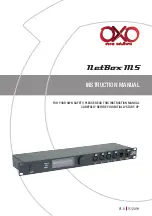
V.T.E. S.r.l.
OWNERS MANUAL
PAGURO 12500
29
12.
GENERATOR INFORMATION
REQUIRED OPERATING SPEED
Run the generator first with no load applied, then at half the generator’s capacity, and loaded to its full capacity as indicated
on the generator’s data. The output voltage should be checked periodically to ensure proper operation of the generating
plant and appliances it supplies. If an AC voltmeter or ampmeter is not installed to monitor voltage and load, check it with a
portable meter and amprobe.
GENERATOR MAINTENANCE
Maintaining reasonable cleanliness is important. Connections of terminal boards and rectifiers may become
corroded, and insulation surfaces may start conducting if salts, dust, engine exhaust, carbon, etc., are allowed to
build up. Clogged ventilation openings may cause excessive heating and reduce life of windings.
For unusually severe conditions, thin rust-inhibiting petroleum based coatings should be sprayed or brushed over all
surfaces to reduce rusting and corrosion.
In addition to periodic cleaning, the generator should inspected for tightness of all connections, evidence of
overheated terminals and loose or damaged wires.
VTE recommends mounting a carbon monoxide detector in the vessel’s living quarters. Carbon monoxide, even in small
amounts, is deadly.
The presence of carbon monoxide indicate an exhaust leak from the engine or generator or from the exhaust elbow/ exhaust
hose, or that fumes from a nearby vessel are entering your boat.
If carbon monoxide is present, ventilate the area with clean air and correct the problem immediately.
13.
GENERATOR TROUBLESHOOTING
Problem
Probable Cause
Remedy
Low no-load voltage
1.
Engine speed too low.
2.
Break down in windings.
1.
Check and adjust rpm.
2.
Check windings resistance.
Proper no load voltage
but low voltage under
load
1.
Low loaded engine speed.
2.
Overload.
1.
Dirty fuel filter; replace.
2.
Check the load indicator.
Unstable voltage
1.
Loose contacts.
2.
Uneven rotation.
1.
Check connections.
2.
Check for uniform rotation speed (dirty fuel filter).
14.
SHORE POWER TRANSFER SWITCH
If the installer connects shore power to the vessel’s AC circuit, this must be done by means of the Shore Power Transfer
Switch. Set the transfer switch shown in the diagrams to the OFF position. This switch prevents simultaneous connections of
shore power to generator output.
CAUTION:
Damage to the generator can result if utility shore power
and generator output are connected at the same time. This
type of generator damage is not covered under the
warranty; it is the installer’s responsibility to make sure all
AC connections are correct.






































